How can you tell your cat’s mood? Is it possible? Like us humans, it is not always easy to detect what is going on in a cat’s head. The cat might not be as happy as you think or your cat could be happy but show different signs that make you think otherwise.
Below we will be covering some of the basics of a cat’s mood for the new to being furparents and some of the not obvious signs for us seasoned furparents. The main reason we wanted to go over this is that sometimes it’s the small stuff we overlook and your furbaby might be trying to tell you something is not right with them.
This post contains affiliate links. We may earn compensation when you click on the links at no additional cost to you.
1. How do you know your cat(s) is happy?
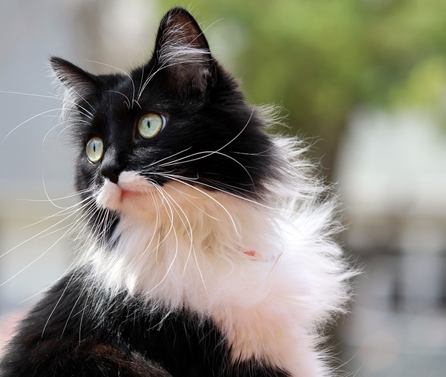
Cats can not literally “say” they are happy but some cats are very vocal if you know the signs. Cats that tend to be vocal will tell you all about it and engage in long conversations. In general, the higher the pitch in their voice, the happier they are. While a lower pitch can mean they are a bit frustrated. But what if I have a quiet cat? Your quiet cat may express happiness with silence and become more vocal to express unhappiness. We know that can be confusing but we think that is why people love their felines, nothing simple about them. Now while their purrs are not always happiness indicators, for the most part, they do show feline contentment or even bliss.
Besides vocal indicators, there are many eye, ear, and body positions that indicate upset cat feelings or happiness. A relaxed, happy cat may rest with front paws tucked under, ears forward, eyelids with the so sleepy look. The eye-blink in response to your gaze from across the room is a happy cat gesture. We just found this out from several pet articles. We always thought our furbabies were sleepy or tired. Sudden dilation of the eyes or wide-eyed can indicate arousal-happiness in response to a full food bowl, a toy, or even something they see that they can get into. Now, this isn’t always a happy sign. Sudden dilation of the eyes or wide-eyed can also be seen with arousal-distress – again, confusing so you will have to pay attention to what is going on around your cat. A joyful cat can even be noticed through their tail. If the tail stands straight up with just the tip crooked it is a greeting to people and other pets that the cat considers friends.
Another sign of a happy cat is that they will show interest in their environment. We know cats are curious by nature. It’s the way they do it that will show you if they are happy. The cat may simply watch calmly from a distance or could be right there in the action. We like to call this the boss micromanaging. While many cats have a built-in stranger danger default, the happy cat reacts with caution rather than fear.
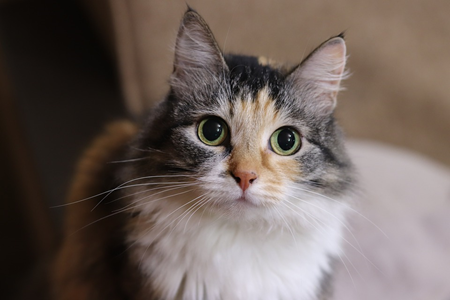
Playing is one of the best indications of happiness. As cats mature and progress into middle and old age, play activity will naturally diminish but should remain present at some level. Any amount of play can indicate feline happiness. Cats play with other critters (and humans) that they like and trust. So, when your cats have wrestling matches with other cats it is not always fighting.
Cats who feel good keep themselves well-groomed, so if your cat is looking rough it might mean they are unhappy or worse a sign of illness or injury. Cats that groom other cats or licking the owner also shows trust and a positive relationship – thus a happy kitty.
2. How do you tell if your cat is sad or mad?
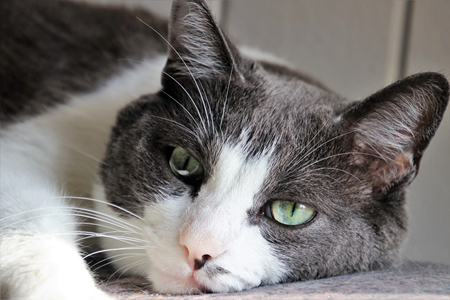
Besides the obvious hissing or fleeing and in some cases cowering other signs could be subtle and not noticed right away that your cat is in distress. To pick up on more subtle displays of an unhappy cat’s behavior cat owners should familiarize themselves with their cat’s body language. Your cat is most likely upset if their ears are held back and their fur is standing on end. There is also their tail language to look out for. If your cat’s tail is tucked, instead of held high, your cat might be annoyed, angry, or scared.
Lethargy is something that unhappy cats can have in common with many unhappy humans. Not to state the obvious, but cats sleep a lot. What if your cat is sleeping more than his/her normal amount of time? Cats that sleep more than usual might be ill or depressed. Unusually low energy is a red flag in an unhappy cat’s behavior, suggesting a mental or physical problem. So, it is extremely important to know your cat and their behavior so that you can spot these signs if they appear.
One of the most common cat traits when a cat is unhappy is just plain aggression. Now granted some cats are just more aggressive then others, but if your cat is acting aggressively out of the blue then give them some space. If your cat continues these behaviors it might be time to contact your vet for a check-up.

Cats are like unruly toddlers for life and they need a routine. Cats tend to flourish when their daily activities follow a consistent pattern and timetable. Cats that suddenly deviate from their habits might be showing signs of distress. Has your cat stopped grooming themselves? Are they not using their litter box? Have they abandoned their usual sleeping spot? If you answered “Yes” to any of these questions, then something might be wrong. Deviations from usual routines are a common unhappy cat behavior.
3. How do you tell if your cat is in physical pain?

You may notice pacing or restlessness because your cat cannot find a comfortable place to lie down. Likewise, he/she may repeatedly get up and lie down to find a comfortable position. You may notice he/she has less energy or decreased endurance to engage in previously enjoyable activities. His/her rear legs may tremble when standing still. He/she may become reluctant to go up or downstairs. You may notice he/she no longer jumps up onto furniture, cat trees, or windowsills.
Most cats who develop painful osteoarthritis stop grooming themselves as much as they used to. They may develop a messy hair coat and may become matted over their painful body parts or do the opposite and will over-groom and traumatize the skin of the areas where they are sore. Cats who are experiencing pain may withdraw from their usual family interactions, may become less engaged in their surroundings and/or may start hiding. You may notice decreased eating and/or drinking. This is the biggest sign something is wrong and we highly recommend when they stop eating or drinking that it is time to visit the vet. You may also notice changes in sleeping patterns. Some may sleep more, while others may sleep less. Some cats that are in pain may start having house-soiling problems because it is uncomfortable to get into and out of the litterbox.
RECAP
How do you know your cat(s) is happy?
How do you tell if your cat is sad or mad?
How do you tell if your cat is in physical pain?
Tell Your Cat’s Mood In 3 Easy Steps. We hope this helps you to learn your kitty and to notice your cat’s mood and what your cat may be trying to tell you. Cats are complex and can not be just broken down to simple understanding. Every cat is different and might have different traits or ways to show you something is wrong. This list is not meant to be everything you can learn about your cat’s mood. These are just some of the common signs what a cat is doing and what they are probably thinking.
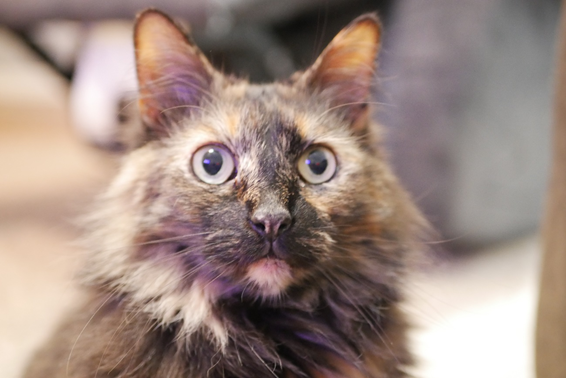
We hope you enjoyed this blog post. If you have any questions or comments please put in the comment section below. Also, don’t forget to sign up for the Kittystead newsletter for future posts, tips and so much more.
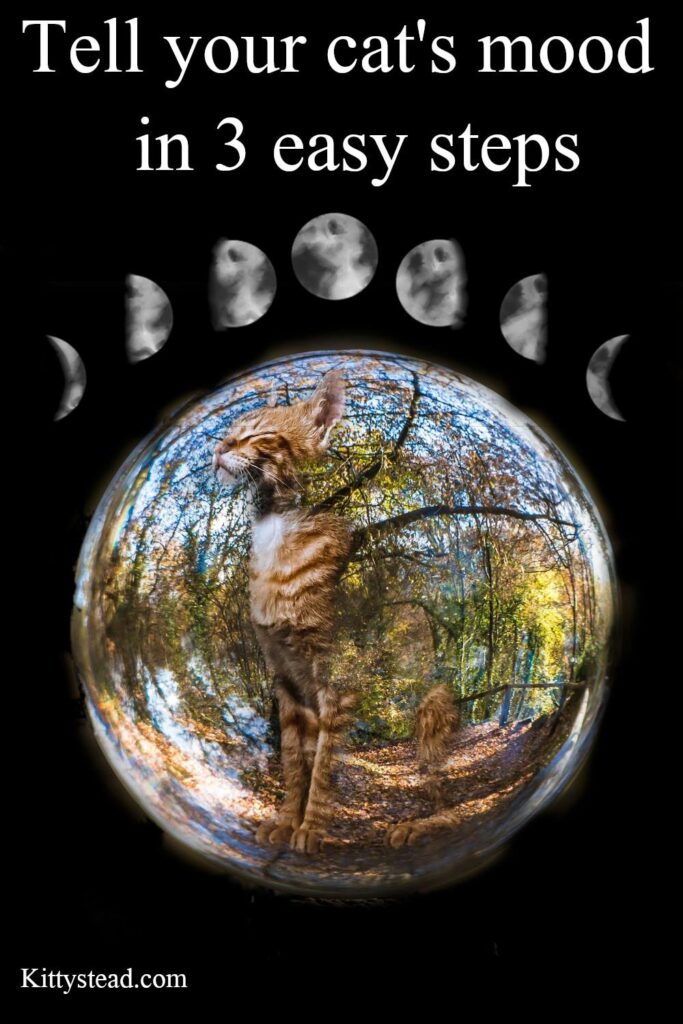

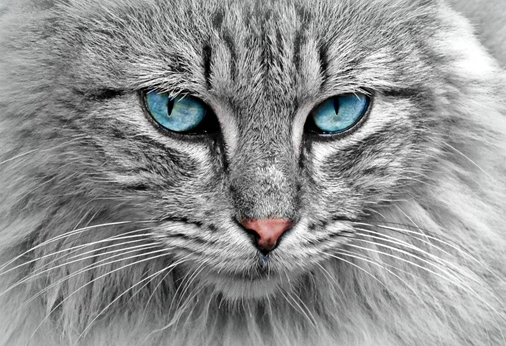





Love this, since we have a cat (3 years) and just got a puppy! We’ve been trying to figure her out moods. This is helpful and let us know if you have any tips for getting your cat to like you new puppy.
Congrats on your new adoption. A new furbaby, especially a puppy can be a handful but SO WORTH IT. Time will be your best friend. lol Holler back if you have any questions. Also, here are a few articles that may help https://kittystead.com/puppy-dog-training-basic-commands/ and https://kittystead.com/5-worst-dog-breeds-for-cat-owners/ Again congrats!
This is a great post. I find it much easier to understand what my two dogs are feeling than my two cats. I haven’t known Tham as long, but now I can use this information to understand them better.
Thank you!
This is so cool! I never knew any of that. While I am officially a dog mom, we have a kitty that kind of adopted us and chose to live in our backyard, this kinda makes me understand her a little bit more.